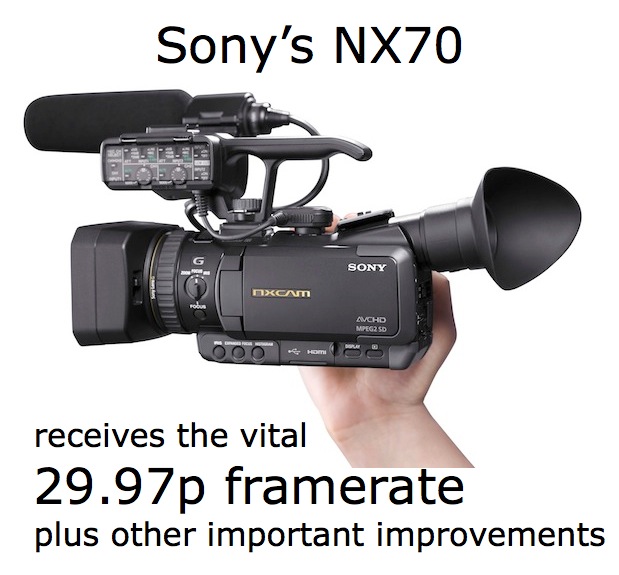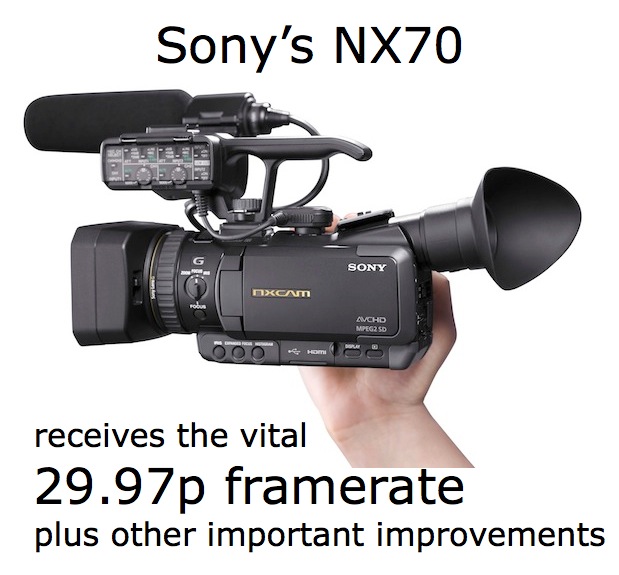
Sony has just announced that the NXCAM camera model known officially as the HXR-NX70 (often followed by a regional suffix) -but colloquially known simply as the NX70- will receive the vital 29.97p framerate via a free downloadable firmware, sometime in the first quarter of 2012. Well, let me get a little more specific: The 59.94Hz segregated versions of the NX70 will get 1080PsF29.97. This article will explain how vital this framerate is for many producers in ex-NTSC countries, and cover some other improvements included in this update, together with a few that are still missing.
This is not a review!
This article is not my promised NX70 review. That will still come sometime in the future, after Sony sends me a review unit, which has been promised by Sony, but has not arrived yet. This article is simply about the additional framerate added to the 59.94Hz segregated version of the NX70, its vital importance, and the other improvements included in the firmware update.
This article is not part of the PsF’s missing workflow series!
This article is not part of the PsF’s missing workflow series, which will continue very soon (and there are several episodes pending).
Framerates the NX70 (59.94Hz segregated version) has had so far
So far, the 59.94Hz segregated version of the NX70 has included:
- 1080/23.976p (progressive) (Called “24p” in the camera’s menu.)
- 1080/59.94p (progressive) (Called “60p” in the camera’s menu.)
- 1080/59.94i (aka 29.97i) (interlaced) (Called “60i” in the camera’s menu.)
Reasons why you might want to shoot 1080/59.94p
Even though 1080/59.94p is not recommendable for general distribution (no over-the-air HDTV ratified standard supports it; Blu-ray video disks don’t support it; I wouldn’t presently recommend it for the web), here are some reasons why you might want to shoot in this mode:
- For final distribution in 720p59.94, especially if you’d like to be able to pan or blow up (magnify) without loss.
- For 2.5x slow motion when the final project is 23.976p, or 2x slow motion when the final project is 29.97p. No time-consuming rendering is required for this type of slow motion: You just have to conform it to the target framerate of your project. This is easily done directly both in Adobe Premiere Pro CS5.5 and Apple Final Cut Pro X. (If your camera doesn’t have this mode… or if you didn’t know in advance what scenes needed to be slow motion, this can also be done very well in post with modern software that adds the “missing” in-between frames, but it takes longer than shooting it at 59.94p.)
REMINDER: Why I no longer recommend 720/50p or 59.94p as a final project format, unless…
There was a time when -for non-dramatic TV productions that weren’t going out to film- my favorite combination (for the sake of smoothness) was 720p50 (ex-PAL countries) or 720p59.94 (ex-NTSC countries). The reason that it was my favorite is because it offers the absolute smoothest progressive playback. The reason I stopped recommending it will be quite familiar to anyone who read (and remembers) my 2010 article Why the iPad will dictate your shooting framerate & shutter speed. To summarize:
- iPads, iPhones, and most (if not all) other phones and tablets have a maximum playback framerate of 30 fps (i.e. 29.97p or the non-standard 30.000p from some DSLRs).
- It is unlikely that you can prevent (even if you wanted to do so) someone from watching your content on one of these mobile devices… and in many cases, you probably encourage it.
- Spatial resolution (pixel count) is very easily downscaled to fit mobile devices, so it’s no problem to create smaller mobile versions of your HD content. However…
- Temporal resolution (framerate) is not easily downscaled without drastically changing the look. If you downscale 59.94p-to-29.97p (or 50p-to-25p), the result is jarring, because the original relationship between framerate and shutter speed -which in combination determine the temporal look of the video- is destroyed (unless you carry out an elaborate frame-by-frame process in After Effects).
That’s why nowadays I generally recommend production framerates between 23.976p and 29.97p (which of course also includes 25p), unless you are specifically producing for networks like ABC, ESPN, Fox News, Fox Sports, NRK, VRT or some other network that broadcasts 720p50 or 720p59.94 due to their preferred emphasis on temporal resolution over spatial resolution, which certainly has its merits. If you are, then of course you can shoot 1080/59.94p (for those in the ex-NTSC countries) or 1080/50p (for those in the ex-PAL countries) and then simply downscale to 720p while retaining the exact original framerate. (The new firmware for the 59.94Hz versions of the NX70 will also add 720p59.94, so the downscale will no longer be necessary if that’s your situation. Presumably, 720p50 will also be added to the 50Hz versions of the NX70 via a similar firmware update. At publication time of this article, there is sadly still no word on a WorldCam update or version of the NX70, but we can still hope!)
The importance of 29.97p
If you are in an NTSC or ex-NTSC country (like the USA, Japan, Canada, or any Latin American country other than Argentina, Paraguay and Uruguay) and want a dramatic “24p” look (or would like to transfer your video to 24fps film fairly easily), then by all means, shoot in 23.976p if you are shooting tapeless (or, if you are shooting on tape, see my 2008 article When 25p beats 24p…). However, if you are in an NTSC or ex-NTSC country (and want to produce the smoothest HD possible (without having a consistency problem when your video hits a tablet or phone, as explained in the prior section), then 29.97p is probably the absolute best progressive framerate for you. It’s relatively smooth, plays back fine on the iPad and iPhone, and plays fine on the web! (23.976p and 25p also play fine on the iPad, iPhone, and on the web, they’re just not as smooth as 29.97p.) This is probably the reason why Sony has decided to add 29.97PsF to the NX70. Perhaps its absence up-until-now is the reason why they hadn’t shipped the promised review camera to me so far. Who knows…
Other improvements included in the NX70 firmware upgrade
In the USA, Sony is adding the following improvements to their regional version of the camera:
- Enhanced performance of zoom rocker operation (Selectable zoom speed).
- Dual Recording Mode enables simultaneous HD recording to its 96GB internal memory and memory card.
- Added 1920×1080 29.97PsF and 1280×720 59.94p recording modes.
- The EXPANDED FOCUS and HISTOGRAM buttons are now assignable keys.
- Added Last Scene Review feature.
- The Display ON/OFF button now also controls display of the Face Detection Box onto video output.
- Display ON/OFF optionally overlays Zebra and/or Histogram display onto video output.
What’s still missing from the firmware update
- A WorldCam (universal) update/upgrade
- All of the items requested in my recent Open letter to professional AVCHD manufacturers
Related articles
- Untapped features in Sony NXCAM’s new HDMI output from June 9, 2011
- PsF’s missing workflow, Part 1: BENIGN PsF versus MALIGNANT PsF from October 23, 2011
- PsF’s missing workflow, Part 2: the Canon XA10 camera from October 26, 2011
- PsF’s missing workflow, Part 3: Sony’s AVCHD & NXCAM cameras from October 31, 2011
- PsF’s missing workflow, Part 4: file-based HD video recorders from November 10, 2011
- PsF’s missing workflow, Part 5: Átomos hires a stripper! from November 11, 2011
- PsF’s missing workflow, Part 6: T©pper asks the camera manufacturers… (An open letter to all professional AVCHD camera manufacturers) from November 14, 2011
- PsF’s missing workflow, Part 7: Adobe Premiere Pro CS5.5.x from November 28, 2011
- PsF’s missing workflow, Part 8: ClipWrap to the rescue from November 30th, 2011
Don’t miss a single article
To make sure you’re up to date on my upcoming articles, sign up for my free mailing list.
Allan T©pper’s books, consulting, articles, seminars, and audio programs
Contact Allan T©pper for consulting, or find a full listing of his books, articles and upcoming seminars and webinars at AllanTepper.com. Listen to his TecnoTur program, which is now available both in Castilian and in English, free of charge. Search for TecnoTur in iTunes or visit TecnoTur.us for more information.
FTC disclosure
None of the manufacturers listed in this article is paying Allan T©pper or TecnoTur LLC specifically to write this article. Some of the manufacturers listed above have contracted T©pper and/or TecnoTur LLC to carry out consulting and/or translations/localizations/transcreations. Many of the manufacturers listed above have sent Allan T©pper review units, Adobe gave him an NFR (not for resale) license of the Adobe programs described, and Divergent Media gave him an NFR of ClipWrap. So far, none of the manufacturers listed above is/are sponsors of the TecnoTur programs, although they are welcome to do so, and some are, may be (or may have been) sponsors of ProVideo Coalition magazine. Some links to third parties listed in this article and/or on this web page may indirectly benefit TecnoTur LLC via affiliate programs.
Copyright and use of this article
The articles contained in the TecnoTur channel in ProVideo Coalition magazine are copyright Allan T©pper/TecnoTur LLC, except where otherwise attributed. Unauthorized use is prohibited without prior approval, except for short quotes which link back to this page, which are encouraged!


